Brain tumor can't stop college goalie from realizing his dream
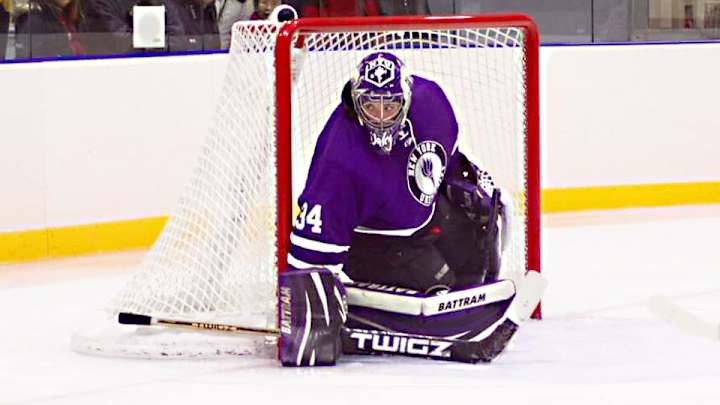
Your teams. Your favorite writers. Wherever you want them. Personalize SI with our new App. Install on iOS (iOS or Android)
The tingling sensation started around October 2014. It felt like Sam Daley's left ring and pinky fingers and the outside of his left foot would fall asleep randomly for 15 or 20 minutes every few days.
Eventually, the tingling got worse, and the then-21-year-old New York University goaltender told his mother, Leslie. A year earlier, Sam had been diagnosed with Bell's palsy, which causes temporary facial weakness or paralysis, and Leslie thought what was going on this time was related to that condition. A trip to a New York City emergency room followed. Sam was told it might be a pinched nerve. He was told to have it checked out if the feeling lasted a couple more weeks. As a hockey player, Sam was accustomed to not always feeling great. But the weird numbness continued.
Early life tragedy steeled Justin Faulk for rise to NHL stardom
"Inside, I knew that it was time that I really got this looked at," he said.
A visit with a neurologist around early December revealed little. The specialist wrote off Sam's symptoms as not serious. Things didn't improve, though, and Sam kept bugging his neurologist until the the doctor gave in and got Sam an appointment for a MRI. Sam mentally prepared himself over winter break leading up to the procedure, which had been scheduled for New Year's Eve. With his team a solid contender for the American Collegiate Hockey Association Division II national championship, worst-case scenarios danced in his mind. The uncertainty of what would be discovered was the worst part.
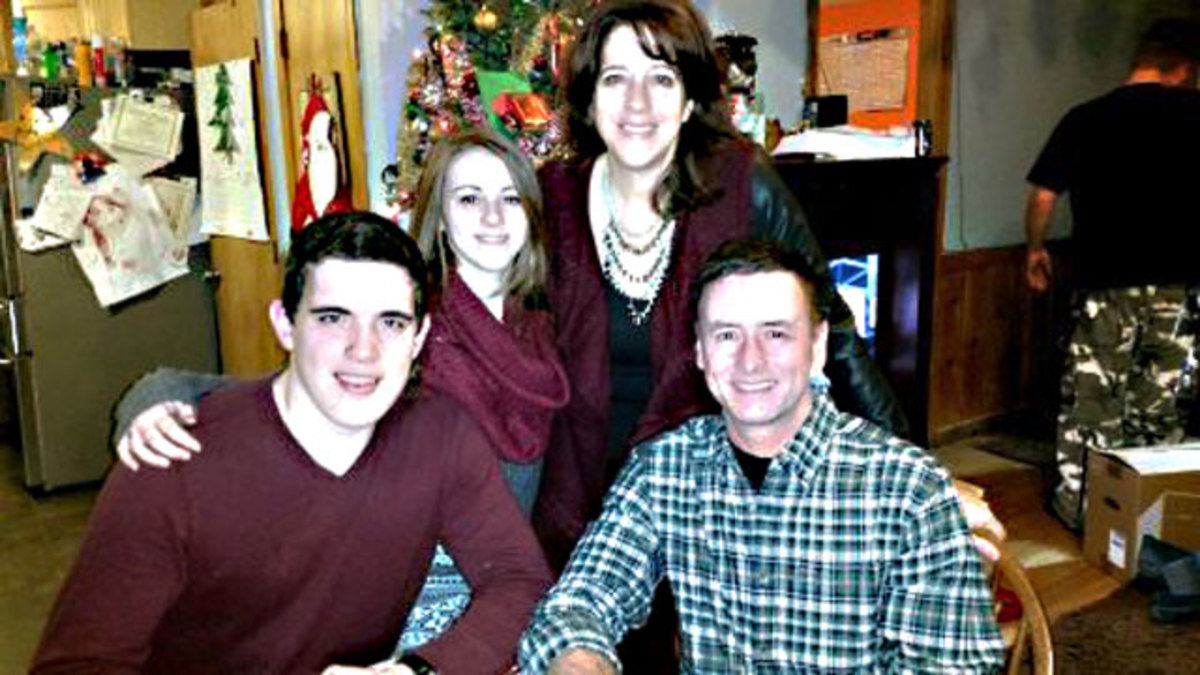
Half asleep, Sam stumbled downstairs and flopped onto the loveseat in his family's living room. A pile of presents sat within arm's reach under the gleaming Christmas pine. Slowly, that pile dwindled, and Leslie ran off to bring out the grand finale.
Puzzled and still groggy, Sam cut the box open and was left with a black bag slightly bigger than his head. Seconds later, he saw the custom goalie mask.
"I really didn't even know what to say, honestly," Sam said. "I definitely woke up real quick after that happened."
The mask was beautiful. NYU's logo had been painted on the mask's purple crown. Lady Liberty adorned the right side. The state seal of New Hampshire, where Sam grew up, decorated the left. His family's coat of arms was placed on the back.
A veteran's sled hockey salvation
Sam planned to break out the new mask when the upperclassman got back to NYU in January 2015 before the start of the second half of the season and, hopefully, another lengthy playoff run. Instead, the plan and Sam's life came to a screeching halt on New Year's Eve when a series of phone calls would ultimately send him to Massachusetts General Hospital for an operation that would try to save his life.
On Dec. 31, Leslie drove the 15 or so minutes from the Daley's home in Bow, N.H., to Concord to take Sam to his 10 a.m. MRI. Results would come in about a week, Sam was told. Leslie didn't think anything would be found. After the appointment, she and Sam ran some errands in preparation for their family's annual New Year's Eve party. While out, the phone rang. Sam needed to return that day for a second MRI.
The first party guests were chatting over hors d'oeuvres in the kitchen with the Daleys when Sam's phone rang around 5:30. Leslie knew who was calling, so she took her son upstairs to her bedroom. On speakerphone, they were told that Sam had a tumor. Sam shook and sat on his mother's bed. In shock, Leslie sat too, as the phone call continued. Sam͛'s stepfather, Jack Daley, opened the door and looked in.
Dr. Brian Nahed called less than an hour later. The neurosurgeon from Mass General told the Daleys that if Sam could get to his office at 7 a.m. on Friday, Jan. 2, he would perform an examination and create a course of action.
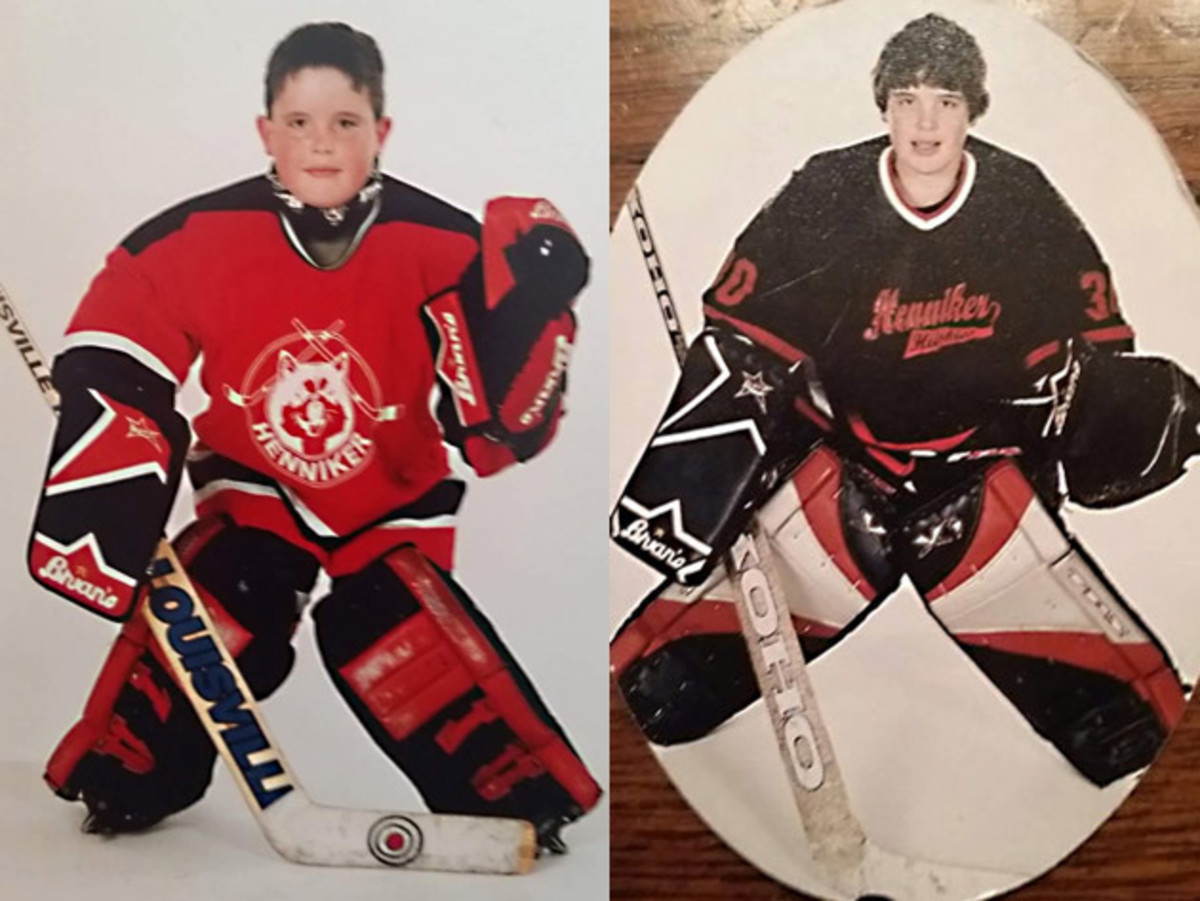
Sam grew up in Bennington, N.H., before moving to Bow when he was 10. He started playing hockey as a six-year-old after his biological father introduced him to the sport. It wasn't long before Sam was set on becoming a goalie. He spent a year playing for Bow High School before starring at Bishop Brady High in Concord. A year off from school to play junior hockey during the 2011–12 season with the New Hampshire Junior Monarchs followed.
In New York City, Chris Cosentino was looking to fill a hole in his roster. A New Yorker by birth, Cosentino coached junior hockey in the Northeast for five seasons before taking over New York University's club hockey program in 2010. So as Cosentino's hunt for a goaltender continued, he decided to reach out to Ryan Frew, his old acquaintance, who was in charge of the Junior Monarchs.
Shannon Szabados breaking through barriers with SPHL’s Cottonmouths
"The first thing Ryan mentioned about Sam was his character and how he's a great kid and a competitor," Cosentino recalled. "Ryan is one of the top coaches in the Northeast in junior hockey. When Ryan gives a recommendation of a player like that, the way he spoke of Sam, it's like, 'all right, this kid must be something special.'"
There was a logjam at goalie during Sam's first season at NYU. Despite sharing the net with three other players, he played in a team-high 15 games as a freshman, posting a 7–5 record with a 2.64 goals-against average and .913 save percentage.
Sam and his teammates advanced to the ACHA Division II national championship tournament during his sophomore year. That season, he finished with an 11-3-1 mark. Cosentino believed that the 2014–15 campaign would likely offer a shot at the national championship. The Violets were returning a solid group of seniors who had gained valuable experience in the tournament. So the coaching staff decided to limit Sam's minutes during the first half of his junior year in hopes of keeping him fresh for when it mattered most. He played in 13 games and had a 9–3 record before he found out about his tumor. "He was playing great," Cosentino said, adding that he didn't see Sam exhibit any signs of deteriorating health. "He never told me that something was wrong."
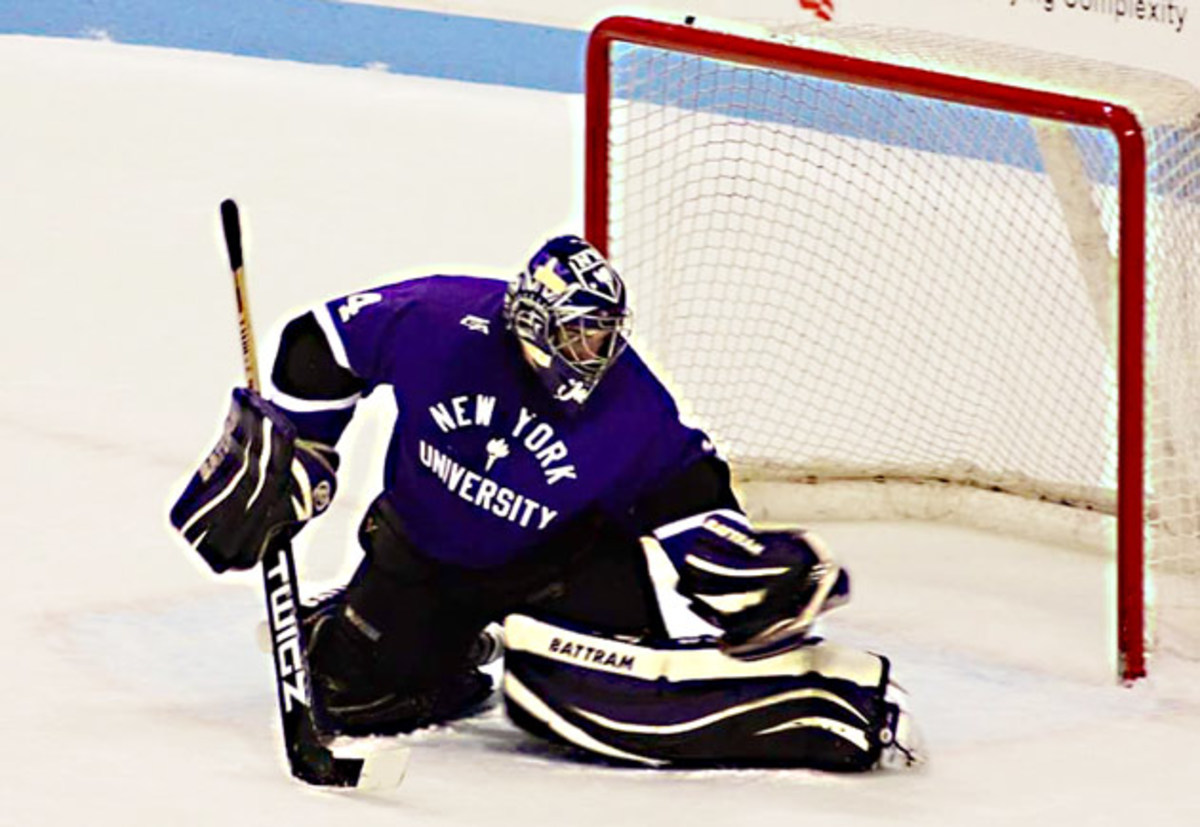
Sam met with Dr. Nahed at Mass General early on Jan. 2, 2015. Surgery was scheduled for Jan. 7. The news took Cosentino by surprise. He later sent an email to the rest of the team and a plan was hatched to let Sam know that he wasn't going to go through the ordeal by himself.
After Sam checked into Mass General on Jan. 6, Leslie, her twin sister and Sam's girlfriend kept him company in his room that night. His teammates offered their support with a compilation of videos that relayed their best wishes.
Jean-Gabriel Pageau: Ottawa’s little sparkplug with the big heart
"I͛'m pretty sure I didn͛'t sleep at all that night before my surgery," Sam said. "If this was going to be it for me, I might as well stay up and enjoy myself for a little bit longer."
Surgery prep started around 6 a.m. Sitting on a cold stool next to Sam's bed, Leslie was the only family member allowed in the room. "Then they kicked me out and they took him away," she said. "It was the worst feeling in my entire life."
Lodged in the fourth ventricle between Sam's cerebellum and brain stem, the tumor was roughly the size of an apricot. The operation was tough at first. The tumor wouldn't budge. Dr. Nahed later told the Daleys he thought the tumor was benign, but added that was just his guess. Pathology results confirmed that guess 10 days later.
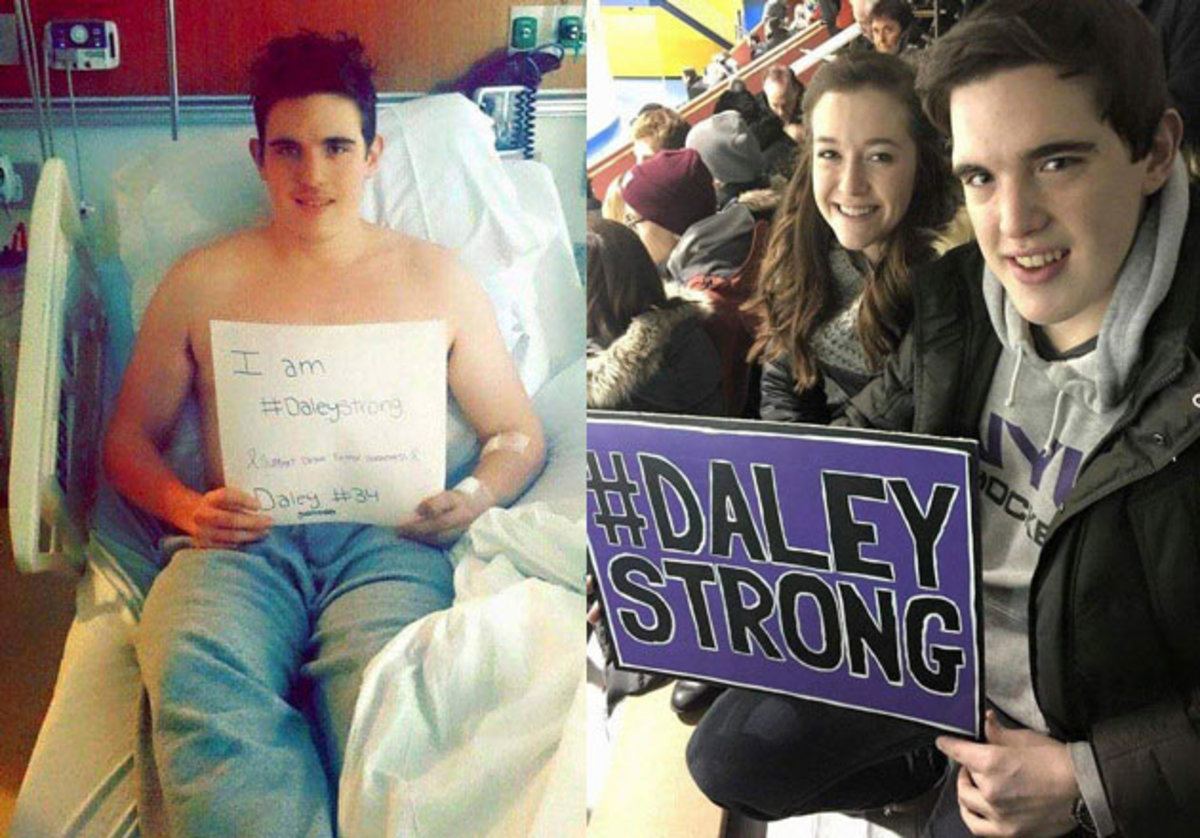
Though Sam didn't have to do any physical therapy after the surgery, he was told he should take off the spring 2015 academic term to recover. Missing the semester would be costly, though. It would mean he'd have to delay starting dental school by a full year after graduating from NYU because he'd miss taking the one last prerequisite course he needed that spring before he could take the Dental Admission Test and apply to schools.
Sam was determined to get back to campus even though he didn't know how well he truly felt. He was medically cleared to return to NYU and on Jan. 30, one week into the semester, he made the trip to Manhattan. Jack wasn't too comfortable with the idea of Sam going back to school so quickly. Leslie wasn't sold either. So she went with Sam, slept on the floor of his single-occupancy dorm room during his first week back and kept a caring eye on him.
Before his surgery, Sam had talked with Dr. Nahed about hockey. The neurosurgeon told him to wait about six weeks and see how things were going. Sam wasn't interested in waiting. He brought up the topic again about three or four weeks after his operation, only to have the conversation go nowhere. Dr. Nahed told Sam he should focus on his studies and make sure he was O.K. handling all the rigors of school before adding hockey onto his plate.
Sam struggled at first. Walking to class while carrying his books was tough. He was mentally drained for the first two or three weeks, too. It was difficult to concentrate for long stretches of time. In the end, taking some time off from hockey for a while was a good thing. "I don't think you really realize how much time hockey takes up until you're not doing it anymore," he said. Instead of spending time at the rink practicing, Sam barricaded himself in the library. "Academically, the semester went better than I could have hoped."
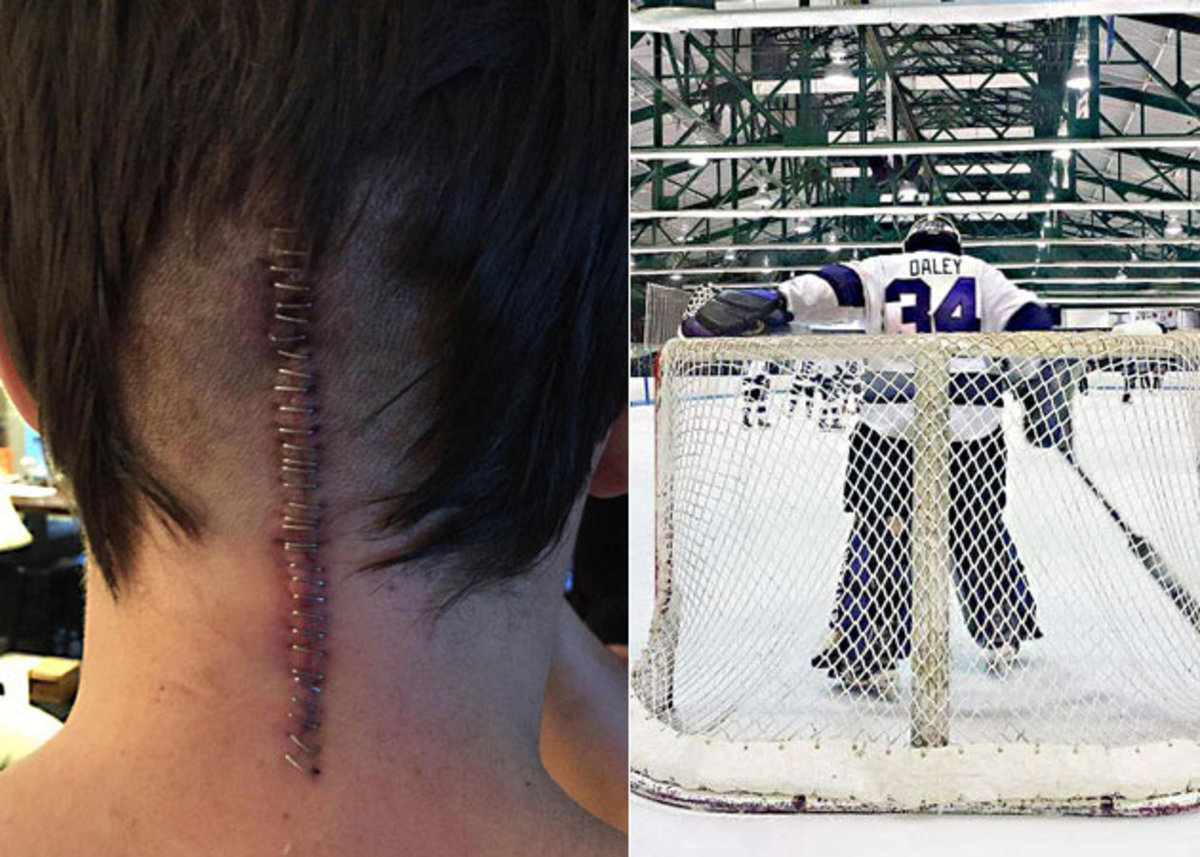
The process of returning to hockey was anything but easy.
Emotionally, it was a rollercoaster ride. Sam knew he wasn't going to have a professional hockey career, but he had a lot to look forward to off the ice. He also learned just how much hockey and his team meant to him.
He was banned from the ice physically. NYU's sports medicine staff wanted written permission from Dr. Nahed before it would approve Sam's return. The neurosurgeon wouldn't write the note because a three-inch-by-three-inch chunk of Sam's skull had been permanently removed during the surgery. A piece of mesh was in its place. The exposed portion of Sam's brain on the back of his head will always be without a true protective layer over it.
Tragedies color Alex Pietrangelo's outlook on life
Sam didn't understand the health risks of returning to hockey until about a month or so after the surgery when Dr. Nahed spelled everything out. Contact from a stick, puck or skate to that unprotected region could result in brain damage, loss of motor function, paralysis or even death. Sam would not be denied, though. He added a new piece of equipment to his gear—a special neck protector made of contoured metal wrapped in foam that looked like an old-fashioned football collar that lineman and linebackers used to wear—and snuck onto the ice around the end of April, a month or so after his NYU teammates beat Florida Gulf Coast University for the 2014–2015 national championship.
"She would have probably had a fit if she knew that," Sam said about Nikki Webb, NYU's coordinator of athletic training services, and his sneaky skates. He laughed and continued. "Honestly, [she] and I were not on great terms at that point, so I don't think her opinion was really on the top of my priority list as to what I was worried about."
Although they were infrequent, his on-ice sessions were a double-edged sword. On one hand, they provided the opportunity to face shots again and get some movement and stretching back into his system. On the other, they revealed a constant fear of being hit by a puck, particularly one that ricocheted off the crossbar behind him. Eventually, it got to the point where he would hear a shot hit metal, and his impulse would be to drop to the ice and cover his head as much as he could.
"It felt like every time I was on the ice, I was like, 'Well, let's hope I can make it through the skate today without getting killed,'" he said.
He didn't give up his attempt at playing again. Dr. Nahed finally wrote Sam͛'s permission note around June after a follow-up examination and a conversation that included Sam showing off his goalie mask and the special collar. Returning to hockey was ultimately Sam's call. However, the neurosurgeon told him that if Sam played his senior season he would have to promise he'd never set foot on ice again.
Lisa Marvin’s long hard road back
The Dental Admission Test was in July, and when Sam wasn't studying for it, he was training feverishly for his final year of hockey. Off-ice work took place four or five days a week. His on-ice time was spent practicing and playing in a local pro-am league. By the end of the summer, he felt better in terms of where he was with his game than he did at that point a year prior.
Sam's custom mask was on full display when he started NYU's season opener. A few games later, the back of his neck started to hurt really badly near the location of the surgical incision. He continued to play a couple more weeks without telling anybody. When word finally got out, Sam was shut down until his next follow-up MRI in early November. His final season was over, he thought, after it barely started.
The results came back fine. Dr. Nahed told Sam that the pain was residual and probably caused by how much stress he was putting on his neck now that he was fully back into the swing of things. It wasn't long before he was back on the ice. "That's just how the whole season was," he explained. "One day I thought my season was over and the next day I was getting ready to play a game. If you ask coach or anyone like that, they'd be like, 'Oh, yeah, he was calm and he was cool the whole year.' But on the other hand, every day was up and down."
A strong late-season push helped propel the Violets back to the ACHA Division II national tournament. After splitting their first two games of pool play, they faced Grand Valley State University on March 20, 2015, in a must-win matchup. Sam got the start after sitting out NYU's loss to Utah State University the day before. GVSU staked an early 2–0 lead. Sam tried to focus on the game and avoid thinking about what losing would mean. Sure, the season would be over, but it would also be time to honor his promise to Dr. Nahed.
ACHA teams turn to Rebirth Sports for creative jerseys
The Violets clawed back with a two-goal third period to tie the game at 3–3 and force overtime. Those were the last goals the defending national champions would score that season. GVSU defenseman Reede Burnett scored the game-winner at 4:23 in the extra period.
Sam walked out of the locker room in a navy suit and started down the long hallway toward the small group of loved ones waiting for him. Slicked back, his black hair was still wet from the shower. His eyes were teary. Walking outside into the raw, dreary evening, they could hear the low rumble of the team's bus.
"Dad, why are you taking the bag from me?" Sam asked his stepfather, who was feeling quite emotional.
"When you started this silly game, I carried your bag because you couldn't do it then, "Jack replied. "So I thought it was appropriate that I carry it on your last day as well."
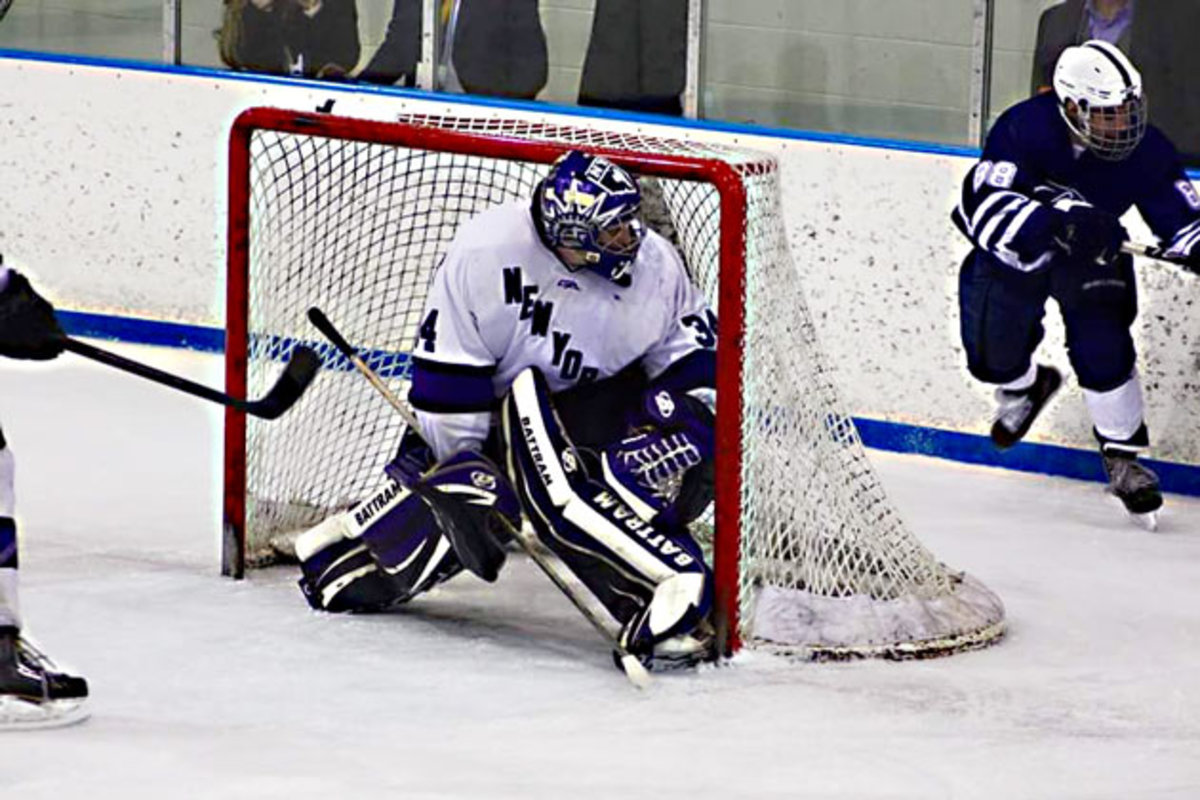
On a low-key night in late March, Sam wore hockey sweats on the couch in his third-floor Manhattan dorm room while the Chicago Blackhawks and Minnesota Wild quietly flashed across the television screen. NYU's season had ended nine days earlier. While keeping the promise he made to his neurosurgeon, he already missed the sport to which he had devoted much of the last 17 years. But his future was something to be excited about. He's healthy now. He graduated on May 18. Dental school at the University of Pennsylvania starts in August. He's going to the Ivy League school for free after winning a full-ride scholarship from the United States Navy, which he'll join as a full-time dentist.
"Before the surgery, I had a plan," Sam said about the tumor and his dream of becoming a dentist. "I wasn't going to let this event change what I wanted to do."
He didn't.
